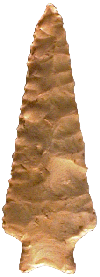

Point Type: HIDDEN
VALLEY
Also See: Gary,
Kirk Stemmed, Langtry, Modoc Contracting Stemmed, Morrow
Mountain, Rice Contracted Stemmed, Searcy
Location: Midwestern United States
Associated Dates:
10,000 - 8,000 B.P. - Early
Archaic
Morphology: Stemmed
General Description: The Hidden Valley is an extremely rare medium to large sized, carefully made, stemmed type that has a large triangular blade and a medium to long stem which contracts from the shoulders to the base. The blade edges can be excurvate, incurvate, recurvate or straight and can be serrated. The shoulders vary from broad and wide to tapered and can be barbed. The base is usually straight to slightly concave. The Hidden Valley is an early example of the use of a distinctly constricted stem. Thinning and smoothing of the hafting area appears on many specimens to show carryover techniques from the Paleo period.
The Hidden Valley most commonly occurs in Illinois and Missouri as well as northeast Oklahoma and into Indiana. The type is similar to the Modoc Contracting Stemmed point. The Hidden Valley was named in 1941 by Robert McCormick Adams for examples which he recovered at the Hidden Valley Rock Shelter, Jefferson County, Missouri. The points were stratified in a layer which produced carbon-14 dates of 6593 B.C.
The Hidden Valley may be easily mistyped as the more common Langtry point in Missouri or Oklahoma.
About The Point Above: The large and highly reworked Hidden Valley point pictured at the top of this page, was found near the town of Kidd, Monroe County, Illinois. The point is made from a waxy, cream colored chert. The edges are mildly serrated and the point has been reworked to a great extent resulting in the loss of most of the shoulders and barb area. The rework was performed by unifacial beveling which has given the specimen a flat, rhomboid cross section. The stem has a concave basal edge and is highly ground and polished and was thinned with flute-like long thinning flakes. This specimen exhibits problematic flairing auricles which give the appearance of a mild expansion rather than a contraction of the stem. Overall, the point measures 72 mm in length, is 28 mm wide across the shoulders, and is only 6 mm thick in mid blade. Typical blade thickness is only 4 mm. The stem is 12 mm long and the base of the stem is 15 mm wide. The stem is 3 mm thick at mid point. The concavity of the base is 2 mm deep. Catalog Number 147-56-D
References: Dragoo (c, e), Overstreet, Perino (1)
© Copyright 1997 - 2008 LITHICS-Net WWW.LITHICSNET.COM
Use your Browser's BACK Button to return to the LITHICS-Net Index.